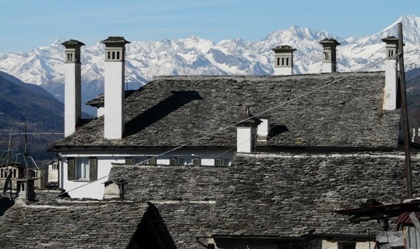
 Vigezzo Valley: the land of painters and chimney sweeps
Vigezzo Valley: the land of painters and chimney sweeps

filled by Giulia & Romeo

If you love the mountains and deny worldly life and clichés, Val Vigezzo will welcome and amaze you with its nature, its history and its passion for tradition.
Walking through the streets and lanes of its villages you will discover why it is called the Valley of the Painters: on one hand the passion of its people for painting is reflected in a clear manner on the facades of the houses that show beautiful frescoes, mostly of religious subjects. Numerous works of local artists are also preserved at the Art Gallery of the School of Fine Arts Rossetti and Visentini, in Santa Maria Maggiore. In the summer here there are lessons and courses in drawing and painting. The artistic reputation of the valley is also given by the beauty of its nature and its villages still untouched by speculation and by mass tourism. There are views that seem created from the hand of an artist.
Santa Maria Maggiore, Druogno Malesco Toceno, Craveggia, Villette, and Re: the several chimneys sprouting on the roofs of stone smoke in the winter and tell the stories of a profession now almost disappeared, the one of the sweeps. In Santa Maria Maggiore a museum shows their evidence, and recalls the years when the Vigezzo people were forced to emigrate in search of fortune, as chimney sweeps, both in Italy, since 1300, and in Europe since 1600. The museum in the park of Villa Antonia collects the tools of this job and photographs and testimonials. In the migration were involved especially the children, whose frail figure allowed an agile climbing in the narrow passages to be swept. Many children left home when they were 6, 7 years old. Some bakeries now sweeten these bitter memories churning out the “kisses of chimney sweeps”, typical biscuits of the place.
In Santa Maria Maggiore walking slowly you’ll discover beautiful mansions dating to the nineteenth century, parks and gardens with mature trees. It’s the valley center and center of international tourism. Above Santa Maria, after the village of Crana, in Toceno you can enjoy one of the best viewpoints in the valley. The mountains that frame all around are impressive.You can see xxx xxx xx xx ......... We reccomend in in Druogno to visit the museum of vintage postcard, which includes about 3000 items.
Another story that characterizes this valley is about Acqua di Colonia: it was a Vigentino man, John Paul Feminis, over three centuries ago, that invented it while he was living as an emigrant in Germany. Prepared with alcohol and finest natural essences that only the Italian flora (and in particular the one of Val Vigezzo) could offer, was initially sold as Aqua Mirabilis, elixir of life to combat headaches, colic, and toothache. It was later appreciated by women for its fragrance and marketed throughout Europe by his great grandson Giovanni Maria Farina, who in 1837 became the official supplier of Queen Victoria of England, whose example was followed by over 50 royalty.
For lovers of the cross-country skiing an oval track combines Malesco, Santa Maria and Druogno, through forests, pine forests and snow glades. From Prestinone by cableway you can reach the ski descent of the plane of Vigezzo (1712) which reach 2000 mt.
The trips are for all levels, from walks that connect the villages together, through meadows and woods, to the street for Lago Ghiacciato for the more experienced, and still the Arvogno valley, Alpe Blitz, Cavallina Mountain, Onsernone Valley, Cortino Valley ... We recommend to collect information and brochures in the local tourist point, which are very well equipped. By Val Loana, fromMalesco, you can also access to the Val Grande National Park, the largest wilderness area in Italy.
The valley of painters can be reached by car via Strada del Sempione (exit Masera Valvigezzo) from Locarno through Centovalli or from Cannobio and Maggiore Lake through Cannobina Valley. By train you can take the Milan Domodossola and then take the historic blue and white train of the vigezzina railroad. A culinary suggestion: stop at the Divine Porcel in Masera for a typical dinner with the raw meat to cook yourself on hot stone, combined with baked potatoes and mayonnaise of different types. A great pit stop to start your weekend, that also from the culinary point of view will not disappoint you: both in the restaurants and in the chalets you will find the meats and cheeses of the valley, besides the typical dishes with polenta and mushrooms, sausage and a variety of wild meat.
|
|






















